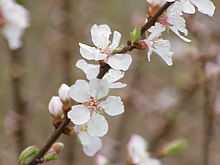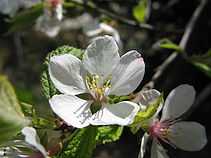Prunus tomentosa
| Prunus tomentosa | |
|---|---|
 | |
| Leaves and fruit (drupes) | |
| Scientific classification | |
| Kingdom: | Plantae |
| (unranked): | Angiosperms |
| (unranked): | Eudicots |
| (unranked): | Rosids |
| Order: | Rosales |
| Family: | Rosaceae |
| Genus: | Prunus |
| Subgenus: | Cerasus |
| Species: | P. tomentosa |
| Binomial name | |
| Prunus tomentosa Thunb. | |
| Synonyms[1] | |
|
List
| |

The Nanking cherry (Prunus tomentosa) is a species of Prunus native to northern and western China (including Tibet), Korea, Mongolia, and possibly northern India (Jammu and Kashmir, though probably only cultivated there).[2][3][4] Other common names for P. tomentosa include Korean cherry, Manchu cherry, downy cherry, Shanghai cherry, Ando cherry, mountain cherry,[5] Chinese bush cherry, Chinese dwarf cherry, or Hansen's bush cherry.
Description
It is a deciduous shrub, irregular in shape, 0.3–3 m (rarely 4 m) high and possibly somewhat wider. The bark is glabrous and copper-tinted black. The leaves are alternate, 2–7 cm long and 1–3.5 cm broad, oval to obovate, acuminate with irregularly serrate margins, rugose, dark green, pubescent above and tomentose below, with glandular petioles. The flowers are white or pink in a scarlet calyx, opening with or before the leaves in spring. They are reliably profuse, arranged in clusters on scarlet pedicels and are 1.5–2.0 cm in diameter. The fruit is a sweet but slightly tart cherry, 5–12 mm (rarely to 25 mm) in diameter, scarlet, ripening in early summer. It prefers full sun and grows naturally in a variety of soils. It is drought-resistant, and cold-resistant to hardiness zone 2.[4][6][7]
Uses
The plant has long been widely cultivated throughout eastern Asia for its flowers and fruit.[4] It was introduced to the British Isles in 1870,[2] and the United States by the Arnold Arboretum in 1892.[8][9][10]
It is cultivated for a number of purposes. The fruit is edible, being an ingredient of juice, jam, and wine, and in pickled vegetables and mushrooms.[10] It is also grown as an ornamental plant, prized for its flowers and fruit, and pruned for bonsai, twin-trunk or clump shapes, or left upright.[9] It is used for dwarfing rootstock for other cherries. In Manchuria and the Midwest United States, the shrub is planted in hedgerows to provide a windbreak. Under cultivation, it flourishes in well-drained, slightly acidic soil.
Several cultivars are grown; examples include 'Graebneriana' (Germany), 'Insularis' (Japan and Korea), 'Leucocarpa' (Manchuria; white fruit), and 'Spaethiana' (Europe).[6]

Classification
Carl Peter Thunberg described the species from cultivated material collected in Japan between August 1775 and November 1776 while based on Dejima Island in Nagasaki Bay. He published it twice, first in Murray's Systema Vegetabilium, ed. 14 (p. 464) in May–June 1784,[3][11] and again in Thunberg's Flora Japonica (p. 203) in August 1784. He described the species as "fol. ovatis subtus tomentosis", leaving no doubt that the plant was named from the tomentum, or wooly hairs, on the underside of the leaves. Murray gives credit to Thunberg.[12]
References
| Wikispecies has information related to: Prunus tomentosa |
| Wikimedia Commons has media related to Prunus tomentosa. |
- ↑ "The Plant List: A Working List of All Plant Species". Retrieved January 27, 2014.
- ↑ 2.0 2.1 Bean, W. J. (1980). Trees and Shrubs Hardy in the British Isles 8th ed., vol. 3. John Murray ISBN 0-7195-2427-X.
- ↑ 3.0 3.1 Germplasm Resources Information Network: Prunus tomentosa
- ↑ 4.0 4.1 4.2 Flora of China: Cerasus tomentosa
- ↑ Note: Mountain cherry is also a common name for Prunus prostrata.
- ↑ 6.0 6.1 Howard, R. A., & Baranov, A. I. (1964). "The Chinese Bush Cherry – Prunus tomentosa" (PDF). Arnoldia 24 (9): 81–6.
- ↑ Griffiths, Mark D.; Huxley, Anthony Julian (1992). The New Royal Horticultural Society dictionary of gardening. London: Macmillan Press. ISBN 0-333-47494-5.
- ↑ Dirr, Michael (1983). Manual of Woody Landscape Plants: Their Identification, Ornamental Characteristics, Culture, Propagation and Uses (3rd ed.). Champaign, Illinois: Stipes Publishing Company. pp. 561–2.
- ↑ 9.0 9.1 Taaffe, G. (2004). Garden Plants of Japan. Timber Press. p. 191. ISBN 0-88192-650-7.
- ↑ 10.0 10.1 Hanelt, P. H. (2001). Mansfield's Encyclopedia of Agriculture and Horticultural Crops. Springer. p. 511. ISBN 3-540-41017-1.
- ↑ Murray, J. A. (1784). Caroli a Linné Equitis Systema Vegetabilium Secundum Clases Ordines Genera Species cum Characteribus et Differentiis: Editio Decima Quarta: Praecedente Longe Auctior et Correctior. Göttingen: Jo. Christ. Dieterich. Downloadable at Google Books.
- ↑ The ICBN requires "Thunb. in Murray" when full bibiographic citation is given, but just "Thunb." when it is not.
See also
| |||||||||||||